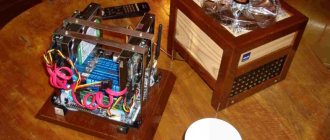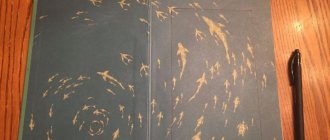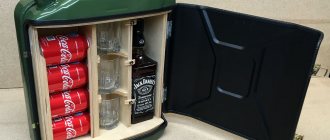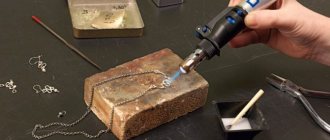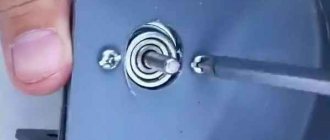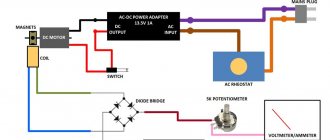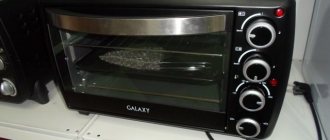We are making a simple device for viewing 3D holograms on your smartphone or tablet. Have you ever wanted to watch videos or watch pictures in 3D without glasses? In this tutorial you will learn how to make a very simple device for viewing 3D holograms on your smartphone or tablet. All you need for this is five minutes of your time. And yes, today we don’t need Arduino, Raspberry and other boards.
How does a 3D pyramid hologram work?
A holographic pyramid is a simple device that can be made by creating a pyramid-shaped shape with the top cut off from a sheet of plastic. The device creates a three-dimensional illusion for the viewer and makes the image or video appear as if it is in the air. Works on the principle of Pepper's Ghost (English Wikipedia). Four symmetrically opposite versions of the same image are projected onto the four faces of the pyramid. Basically, each side projects the image falling on it into the center of the pyramid. These projections work in unison to form an entire figure that creates a three-dimensional illusion.
A small clarification!
A hologram is a three-dimensional image obtained by the holographic method, this is exactly how it is written in Ozhegov’s explanatory dictionary. In the modern explanatory dictionary of the Russian language T.F. Efremova says that a hologram is a three-dimensional image of an object on a photographic plate obtained by the holography method. It turns out that a hologram is something “flat”, but imitating volume.
Why am I saying this? And to the fact that today in this area there is a huge confusion with terms! Today, the variety of volumetric and aerosol displays, various kinds of projections are usually called holograms so that ordinary people quickly understand what is being discussed. Therefore, when the news talks about how a hologram of a famous person appeared on stage, then usually we are talking about the most banal projection.
There are more advanced projections, these are already aerosol screens.
The article will focus on volumetric displays that can show a three-dimensional image from all angles. Volumetric displays are conventionally divided into 2 types:
Static volume - these devices do not have macroscopic moving parts (screens or mirrors). A classic example is LED cubes, when at each point in space a voxel is an LED. Currently, such cubes are distributed as toys.
Swept volume is a type of display with a moving screen that works through persistence. This is the type I tried to collect.
Creating a pyramid for 3D holograms
1. Print out the template shown below on a piece of A4 paper.
NOTE : If you don't have access to a printer, you can also create the template yourself. Draw a basic "trapezoid" on a piece of paper using the dimensions in the picture above. Parallel sides = 1 cm and 6 cm, the other two sides are 4.5 cm each. You can always double or triple the sizes proportionally for use on a larger display.
2. Trace the shape onto the plastic sheet using a ruler and pen. For a trapezoidal template, mark four similar outlines on a plastic sheet. Now carefully cut out the outlines with a cutting blade and a ruler. Try to make your cuts as precise as possible to create a more perfect pyramid.
3. If you used a print template: very lightly score the red edges using a cutting blade. This will allow you to better fold the edges and form a pyramid shape. Seal the open edges of the sheet together using clear tape.
If you used a trapezoidal template: Bring the four edges together to form a pyramid shape. Connect them. Either way, you will end up with a pyramid like the one shown below.
4. That's it! You have made yourself a pyramid for future holograms! All you have to do now is play the hologram on your phone. Place the hologram in the center of the screen as shown in the picture below and enjoy the show. Remember to turn off the lights in the room before you start playing the video.
5. Now the most important thing! You can find many holograms on YouTube. You can see what can happen in the video below.
Principle of operation
Persistence, also known as inertia of vision, is the ability of the eye to combine rapidly changing images into one motionless one. Imagine 2 pictures. If they quickly replace each other, they will merge into one. A good example is the thaumatrope:
Movable screens of such volumetric displays can be rectangular, disk-shaped or with a helical cross-section. The main thing is that the screen should move so quickly that a bunch of static pictures merge into one three-dimensional one.
Drawing a trapezoid
After all the necessary elements have been prepared, you should begin drawing a trapezoid (stencil). To do this, take a sheet of paper and, using a ruler and pencil, draw a trapezoid with the following sides:
After finishing, take scissors and cut out the resulting trapezoid. This will be a stencil with which the walls of the future pyramid will be made.
Cut trapezoids from CD boxes (4 pieces)
This is the most labor-intensive stage of making a pyramid, requiring increased attention. The reason for the complexity is that the plastic from which the CD box is made is very fragile and can begin to crack under strong pressure.
Principles of Physics
Amplitude and phase characterize wave objects. You can register the amplitude without any problems. A real holographic pyramid can be recorded without any problems by ordinary photographic film. She transforms it into photographic blackening. Interference is needed to register the phase relationships of the holographic pyramid. It converts it into phase amplitude relationships. Interference is created using several electromagnetic waves.
The frequencies of these waves of the holographic pyramid must match. Two waves must be added in a specific area to record a hologram. One of these areas is the reference wave. The other is the object wave of the holographic pyramid. At this point you need to insert a record or any other material. As a result, a picture appears in this area. To obtain an object wave, you need to illuminate this plate with a reference wave. As a result, we will receive the same light that is reflected from the recording object.
Hologram on a smartphone. The hoax of the century or is the future already here?
In July 2022, he announced a new smartphone “RED HYDROGEN”
The very news about RED and smartphones discouraged many ordinary people: “Seriously?
They make cameras - what other smartphones..." But even more unexpected was the statement that the smartphone would support holograms
!
Many decided that the guys had gone crazy, or this was some kind of hoax of the century, strange PR, or... Is this really possible? Maybe a lightsaber is just around the corner?
- Yes it is possible.
But not as Hollywood portrays to us - we will not see the projection of Princess Leia. Most likely, you simply don’t know what a hologram is because you watched a lot of science fiction instead of studying physics. It is precisely for such people that this article was written - simply about the complex.
Holography vs Photography
— What are holograms? Let's look at Wikipedia...
Holography is a set of technologies for accurately recording, reproducing and reshaping the wave fields of optical electromagnetic radiation, a special photographic method in which, using a laser, images of three-dimensional objects are recorded and then reconstructed, highly similar to real ones.
Most likely there is no increase in understanding - it’s better to watch the video. If it seemed to you that these were mirrors and cans of forfeit behind glass, look again. These are real holograms.
No tricks, just science.
How it works?
First, let's answer the question - how do we generally perceive volume
? This is possible due to the fact that we have two eyes - each sees an object from different sides. The brain processes these two slightly different pictures and builds one three-dimensional model in our minds. Thanks to this, we can estimate the distance to objects simply by looking at them - the brain automatically evaluates the tension of the eye muscles and determines the distance with fairly high accuracy.
The eye as an optical device
The camera works on the same principles as the human eye - so let's consider the eye as an optical device.
The eye reacts to light
, and light, as you know, is
an electromagnetic wave
, exactly the same as, for example, Wi-Fi - only
at a higher frequency
.
In order for the eye to see something, light must come into it from this point; when we see some object, we register what is reflected by this object in all directions
light that is reflected
in all directions by every point on the surface
Every point on the surface reflects light in all directions!
This is an extremely important principle that needs to be understood - a whole mixture of different waves passes through every piece of space in a variety of directions, but we only see what enters our eye through the pupil.
Out of the whole mess of waves, only a small piece of the wave that slips through the pupil gets into the eye/camera.
The wave goes further, but we don’t see it because our eye cannot register waves that do not go straight into it, but this does not mean that they are not there
!
When we turn our head to see an object from the side, pieces of waves reflected from this object begin to fall into our eye.
These waves have always been here
, they are simply invisible to the eye until they go into it from the front.
A camera/movie camera works on the same principle - out of the whole variety of waves passing in all directions through space, only the part that goes in one direction is recorded
- that’s why the photos look flat - this is just
a small part of the original information
Holography
Now we can finally move on to the principle of creating three-dimensional images
, consider the part of the space outlined in purple, imagine that we have placed glass in front of the object.
If we were able to somehow freeze/remember the pattern of waves passing through this glass, and then reproduce exactly all the amplitudes, frequencies and phases
, then we would store not a small green piece of the wave that carries information about only
one direction
, but a whole picture of all waves, which contains information about all possible viewing angles.
If you can't see the difference...
If exactly the same picture of the waves that the object emitted at the time of “sealing”
this picture comes out of the glass, it will be visually impossible to distinguish such a
“photograph”
from the real object, and the object will be visible from all angles since the entire picture of the waves passing through space The camera sees only in one direction - so in order to capture the entire wave front, we need to take pictures in all directions, and then combine them into one three-dimensional picture - 3D scanning is based on this principle.
This method of shooting 3D objects is similar to FDM 3D printing with plastic, which in fact is printed in 2D simply many, many times - at a qualitative level it is a “crutch”
Implementation
It’s a small matter - all that remains is to figure out how to seal in space all the radio waves that pass through it, and then restore it, here I probably won’t go into technical details - the main thing is to understand the basic principle. (If there is interest, it is possible to shoot a hologram in the spectroscopy laboratory, there are many nuances here - so this is a topic for the next article).
Stopping the light
The problem is that the waves are in constant motion
.
And if we want to fix a picture in space, we must react with some kind of photosensitive material for some time and the sealed picture must be motionless for this time
.
When taking a regular photograph, we do not stop the light, we cut out a narrow direction along which we expose the matrix with rays of constant amplitude, each of which connects an object point and a pixel on the matrix.
Standing waves
We want to capture all directions at once
, and we don’t have
Agamoto’s eye
to freeze time - we’ll have to think with our heads.
It’s good that this was already done back in 1947 by Denesh Gabor
(one thousand nine hundred and forty-seven, Karl!). For which he received the Nobel Prize.
The point is this: if you add two waves with the same frequency and different directions, then at the intersection of the maxima and minima of these waves a standing wave
- a virtual wave (since light waves do not act on each other), which is the sum of two traveling waves of the same frequency. Due to this, it is possible to illuminate a motionless picture from the intersections of two waves in a photographic plate.
By illuminating one plate with three colors of reference waves - red, blue and green - we get a full-color hologram indistinguishable from the original.
If you now remove the object and shine a reference wave onto the plate, an exact copy of the waves that the scanned object created will come out of the plate.
Technological requirements
Since it is very important that the frequencies of the object and reference waves are the same - an incredibly stable light source is needed so that the standing wave remains motionless - with a slight difference in frequencies, the wave will begin to move and the hologram will blur.
Green light
Such a source exists - it is called a laser
. Before the invention of the laser in 1960, holography was not commercially developed; gas-discharge lamps were used for recording.
In 2009, the world's first semiconductor green laser
(red and blue were already there). Previously, green lasers used frequency doubling of an infrared laser diode passed through a frequency doubling nonlinear optical crystal. However, this design has extremely low efficiency, high cost, complexity, etc.
Invention of the semiconductor green laser
gave the green light to the development of miniature
RGB laser projectors
. 9 years have already passed - quite enough time for the technology to transition to industrial use - and now we are beginning to observe the most active market participants, soon there will be even more cool and interesting products
Resolution
The resolution of the recording plate must be incredibly high - after all, the distance between the illuminated nodes of the standing wave is comparable to the wavelength of light, which is ~600 nm!
That is, the resolution is at least 1666 mm^-1. all points falls on each point of the matrix
object, that is, each part of the hologram contains information about the entire object.
Conclusions:
- The principle of holography was invented half a century ago, but it was not possible to implement it at a good level due to the lack of technology - in particular lasers, recording materials
- Even using ordinary plates - creating a hologram is a rather delicate and painstaking process - making a holographic full-color scanner and a digitally controlled holographic screen in a smartphone is a very strong challenge.
- Even the ability to take one static hologram from a tripod (not to mention recording a hologram handheld) and display it on a revolutionary holographic display in the form factor of a smartphone will already be an achievement that will change entire industries.
PS Holography is also used in the production of processors and microscopy, allowing one to overcome the diffraction limit of a conventional photomask.
UPD:
Thanks for the comment gritchenkoant
Relatively recently there was an article about cameras and light field displays, it seems that RED is preparing its new product on this basis spie.org/newsroom/6623-high-resolution-3d-light-field-display?SSO=1
Place the design on the phone
Now the last step remains and you can see a 3D hologram in the middle of the pyramid. In the first seconds after starting the video, a drawing appears in the form of a cross, along the edges of which you need to place the made pyramid. For more accurate placement, it is better to press pause and set it as needed.
This is how, using available tools, you can make a pyramid in 5 minutes, in the center of which you will see a 3D image. Thanks to the variety of available videos, you can watch and surprise others with different holograms and even use them as a night light.
(24 votes, average: 4 out of 5) Share with your friends!
Pyramid dimensions
The holographic pyramid has the following dimensions: the width of the upper part of the stencil is 10 mm, the lower part is 60 mm, and the height is 35 mm. It is also very important that the pyramid should be at an angle of 45 degrees. Next, attach the stencil to the glass. It needs to be temporarily glued with double-sided tape. Next, we’ll make cuts using a knife and break off the glass using pliers. First, you can clamp the workpiece in a vice.
As a result, the workpiece should look like a triangle. We process chips with sandpaper. We perform the same actions 3 more times. As a result, we should have four pieces of workpiece.
When all the blanks are ready, you need to remove the backings and glue them together with a glue gun. Our task is completed, so that we can see the illusion, we need to install it in the center on the smartphone screen. You also need to cover the pyramid with a piece of cardboard. We launch the picture and observe from any angle.
Size rules
Today you can find a special video for a 3D hologram on the networks. Animated images, usually shown on a black background, are the basis for a 3D projection that will appear in a transparent pyramid. You need to download them and enable them on the device screen. To check the size fits you need to do the following.
If all parameters are correct, the prism for the monitor can be considered ready and suitable for use when reproducing a three-dimensional image.
The picture created in the center of the prism will attract the attention of both children and adults.
A little history
The hologram illusion has been around for a long time. Similar equipment has been used in theaters, parks, museums and concerts since the 19th century. The effect was called Pepper's Ghost after the scientist D.H. Pepper, who spread the phenomenon through demonstration. This was in 1862, and today the art of holograms has reached perfection. The world began to become acquainted with the phenomenon back in the 16th century, when the Neapolitan scientist Giambattista della Porta developed an illusion camera. He also wrote the work “Natural Magic”, which is the first mention of the reproduction of illusions. The scientist considered the question of how objects that are not actually there can be seen in the camera.
Modern Application
Modern examples today include transparent and translucent attractions in the Walt Disney parks. The world knows them as the largest implementations of this idea. Several effects are collected on a long stage. A giant 9.1 m hologram is viewed in an empty ballroom. Animated ghosts move in hidden black rooms. The most modern version is used in the Twilight Zone Tower of Terror.
The Nashville attraction uses a classic technique, allowing guests to see spirits interacting with the environment. They can be seen especially close. California also has a Halloween attraction in the Forest Mountains featuring story characters. Projecting an image onto the floor and reflecting it in glass allows a live actor to interact with the ghost, which is used in plays. The world can see the phenomenon in the Netherlands, Australia, America, museums, parks, science exhibitions and attractions. Illusion finds application in various fields:
The story about creating 3D images should end with a phrase from the character Bill Cipher from the animated series Gravity Falls: “Remember that reality is an illusion, the universe is a hologram, buy gold!” This hero, drawn in the form of an all-seeing eye, according to the idea of the cartoon, appeared from the second dimension of “flat minds”. He could inhabit the mind, visit dreams and had a dark sense of humor. Hating his fellow tribesmen, he destroyed the second dimension and helped the third to manifest itself.
Required Items
To see a 3D image on a smartphone, you first need to make a 3D pyramid. What elements are needed to make it:
- a simple pencil;
- marker;
- ruler (not necessarily long);
- paper (preferably checkered so as not to use a protractor);
- scissors (to cut out the stencil);
- knife (a stationery knife is ideal);
- tape (transparent, narrow) or glue for plastic;
- plastic containers from CDs (transparent).
Materials for creating a hologram
Now let’s touch on a topic like “Fixed Hologram”. How to make it? Prepare:
- holographic plates;
- laser pointer;
- subject for a future hologram;
- night light;
- a book or similar item;
- photosensitive powder;
- 4 containers with distilled water;
- hairdryer
